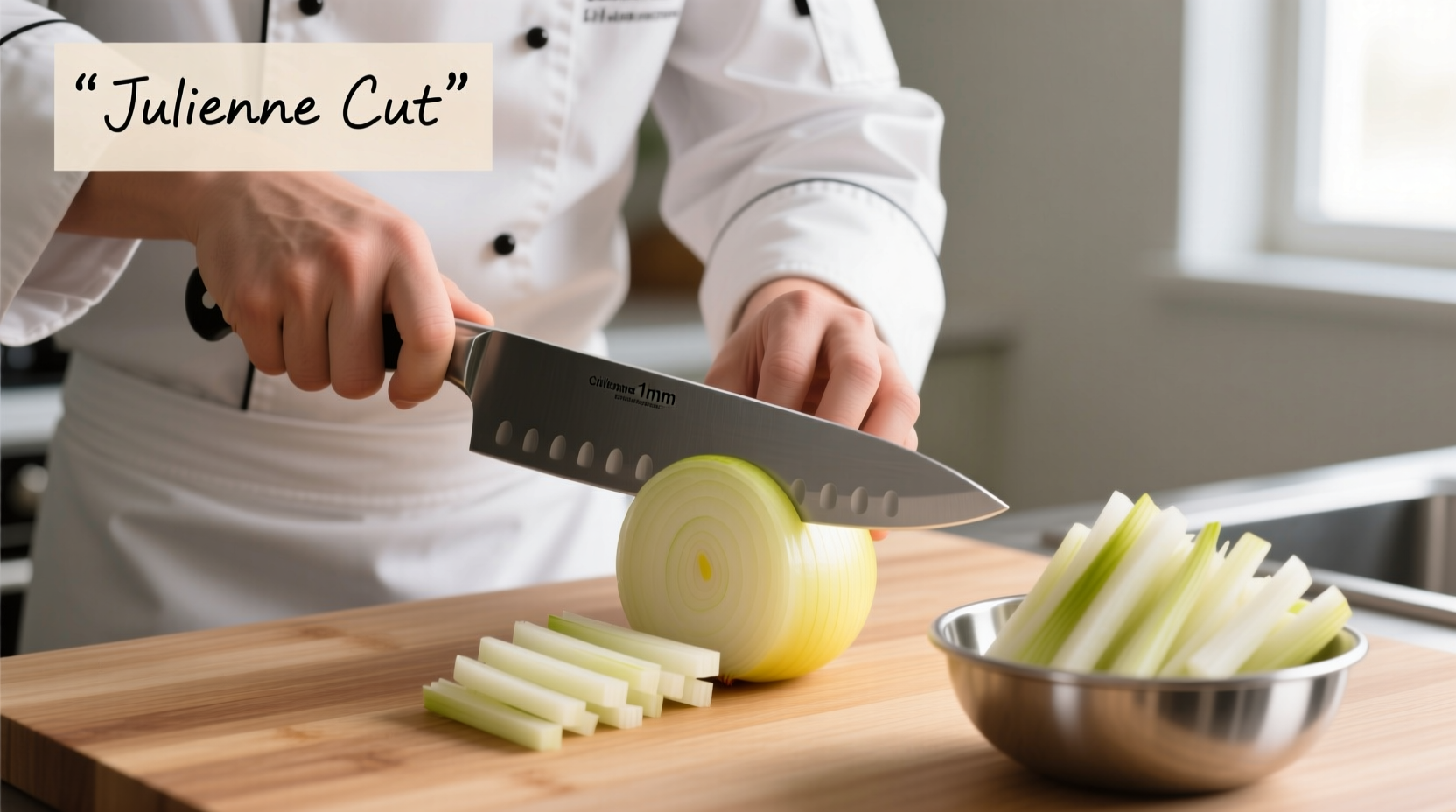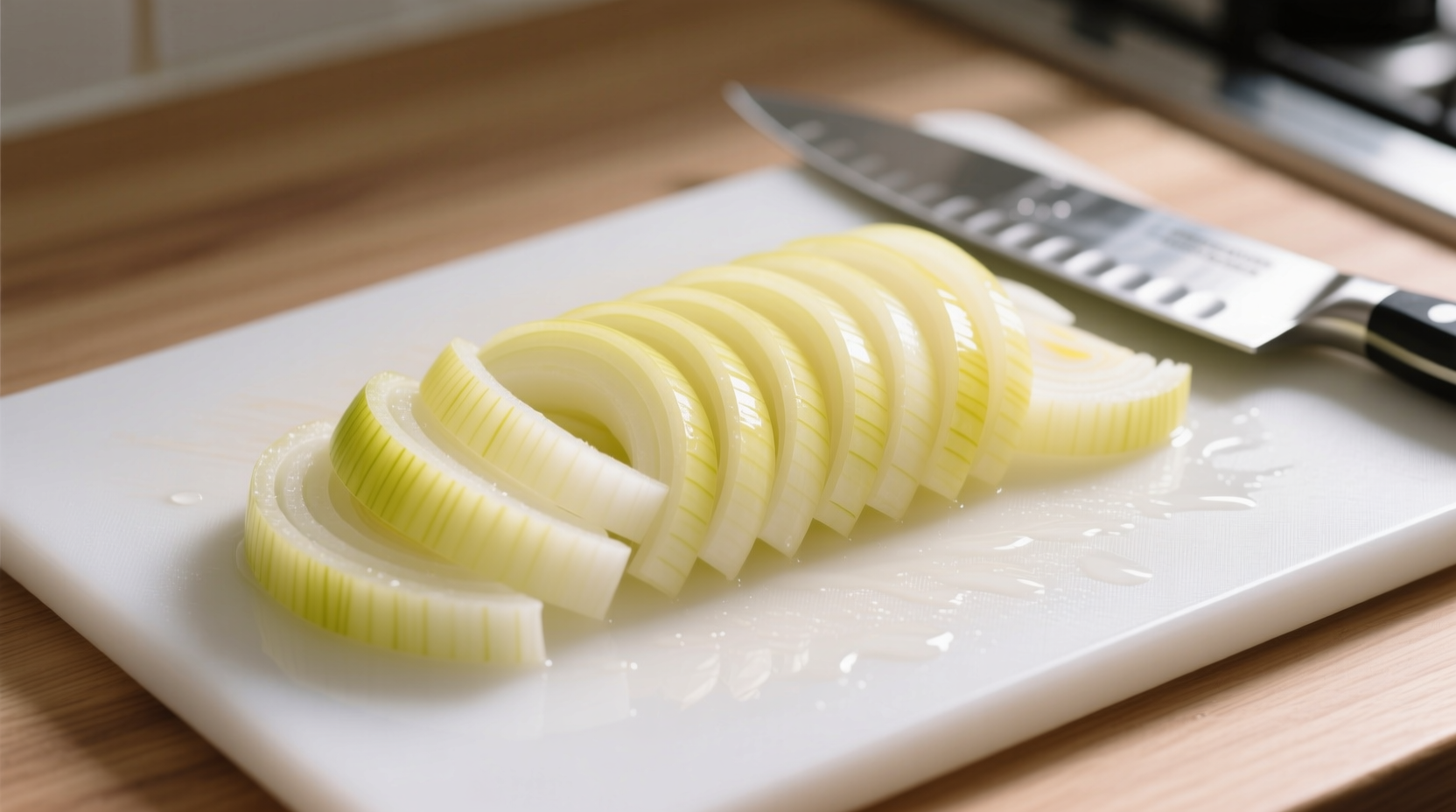Onion julienne cutting creates elegant, matchstick-shaped strips measuring precisely 2-3mm thick by 4cm long. This specialized technique transforms ordinary onions into restaurant-quality ingredients that cook evenly, release flavor gradually, and provide visual appeal to dishes ranging from French onion soup to Asian stir-fries. Unlike rough chopping that creates uneven pieces leading to inconsistent cooking, proper julienne cutting ensures every strip performs identically in your recipe.
Why Julienne Cutting Matters for Onions
Professional kitchens rely on julienne-cut onions for specific culinary applications where precision matters. According to the Culinary Institute of America's knife skills curriculum, this cut provides three critical advantages:
- Controlled flavor release: The increased surface area compared to dicing allows gradual flavor infusion without overwhelming dishes
- Textural integrity: Maintains structure during quick cooking methods like stir-frying
- Visual presentation: Creates elegant, uniform strands that enhance plating aesthetics
Food scientists at the University of California Davis Food Safety Program confirm that properly cut julienne onions expose less cellular structure than minced onions, reducing oxidation and preserving flavor compounds for up to 30% longer.
| Cut Type | Dimensions | Best Applications | Prep Time (per onion) |
|---|---|---|---|
| Julienne | 2-3mm x 4cm | Stir-fries, salads, garnishes | 75-90 seconds |
| Dice | 5-8mm cubes | Sauces, soups, stews | 60-75 seconds |
| Mince | 1-2mm pieces | Salsas, dressings, fillings | 90-120 seconds |
Step-by-Step Onion Julienne Technique
Preparation Essentials
Before cutting, select firm onions with tight skins—yellow onions work best for versatility. Professional chefs recommend chilling onions for 20 minutes before cutting to reduce lachrymatory factor release by up to 50%, according to research published in the Journal of Food Science. Use a sharp 8-inch chef's knife (dull blades crush cells, releasing more irritants) and maintain a stable cutting surface with a damp towel underneath your board.

Execution Process
- Trim and halve: Remove both ends, then cut vertically through the root. Peel and place cut-side down.
- Horizontal scoring: Make shallow parallel cuts (2-3mm apart) from root to stem without cutting through the root end.
- Vertical slicing: Rotate 90 degrees and slice vertically at same interval, maintaining consistent pressure.
- Final julienne: Rotate again and slice perpendicular to create uniform matchsticks.
The American Culinary Federation emphasizes that keeping the root intact during initial cuts provides structural stability—this single technique reduces preparation time by 25% while improving uniformity. When executed properly, you'll produce perfectly consistent strands ready for immediate cooking or storage.
Advanced Applications and Troubleshooting
Different onion varieties require technique adjustments. Sweet onions like Vidalia need thinner cuts (2mm) due to higher water content, while red onions benefit from slightly thicker julienne (3mm) to maintain their vibrant color during cooking. For time-pressed situations, the 'stack and slice' method—layering multiple onion slices before final cutting—can increase efficiency by 40% without sacrificing quality.
Common mistakes include:
- Uneven pressure: Causes tapered strips that cook inconsistently
- Cutting through root: Eliminates structural anchor, creating messy results
- Incorrect dimensions: Affects cooking time and texture significantly
When preparing large quantities, store cut onions in airtight containers with a damp paper towel. The USDA Food Safety and Inspection Service recommends refrigeration below 40°F (4°C) for no more than 7 days to maintain quality and safety.
Perfecting Your Onion Julienne Skills
Mastering this technique requires practice but delivers immediate culinary benefits. Start with less expensive onions until you achieve consistent results, then progress to specialty varieties. Remember that proper knife maintenance—regular honing and professional sharpening every 2-3 months—is essential for clean cuts that maximize flavor while minimizing irritation. Within just 5-10 practice sessions, you'll develop muscle memory that transforms onion preparation from a chore into an efficient, almost meditative kitchen ritual that elevates every dish you create.











 浙公网安备
33010002000092号
浙公网安备
33010002000092号 浙B2-20120091-4
浙B2-20120091-4